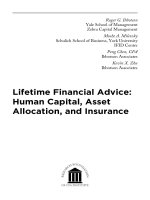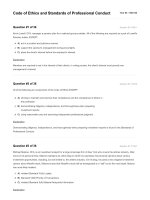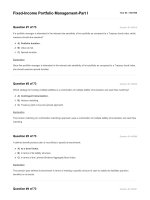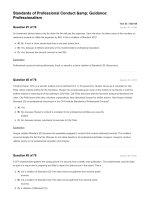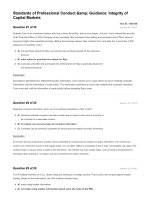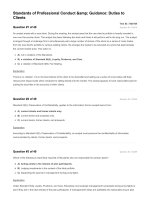Schweser QBank 2017 portfolio management and wealth planning 09 asset allocation and relat portfolio management (2)
Bạn đang xem bản rút gọn của tài liệu. Xem và tải ngay bản đầy đủ của tài liệu tại đây (119.34 KB, 15 trang )
Asset Allocation and Related Decisions in Portfolio Management (2)
Test ID: 7427763
Question #1 of 38
Question ID: 472661
Which of the following statements regarding benchmarks and indexes is most accurate?
ᅞ A) Indexes are used in performance evaluation.
ᅚ B) Benchmarks and indexes are used in performance evaluation.
ᅞ C) Benchmarks are used in performance evaluation.
Explanation
Benchmarks are the reference point used in performance evaluation and indexes are often used as that benchmark for
performance evaluation.
Question #2 of 38
Question ID: 472683
Which of the following investors would benefit most from the use of a custom benchmark?
ᅞ A) A foundation that wants to beat the overall market return.
ᅚ B) A pension plan that has liabilities that include future wage growth and inflation
indexing.
ᅞ C) An investor who wants to earn the market return of a balanced asset allocation
between equities and bonds.
Explanation
The pension plan would most likely need to create a custom benchmark that would mimic the liabilities using a combination of
nominal and inflation indexed bonds and equity for wage growth. The foundation could use a market index as its benchmark
and the individual investor would most likely use a target date fund or a balanced fund as their investment vehicle both of
which would use a benchmark that could be constructed from equity and bond indices.
Question #3 of 38
Question ID: 472651
A U.S. investor who holds a £2,000,000 investment wishes to hedge the portfolio against currency risk. The investor should:
ᅞ A) sell $2,000,000 worth of futures for British pounds.
ᅚ B) sell £2,000,000 worth of futures for U.S. dollars.
ᅞ C) buy £2,000,000 worth of futures for U.S. dollars.
Explanation
The investor should sell £2,000,000 worth of futures contracts for U.S. dollars. This will offset the existing long position in
pound-denominated assets. In so doing, the investor has effectively fixed the exchange rate for pounds into dollars for the
duration of the futures contract.
Question #4 of 38
Question ID: 475727
Portfolio managers tracking international equity indices have a tradeoff between completeness and investability because:
ᅞ A) higher completeness results in higher investability and lower transaction
costs.
ᅚ B) higher completeness results in lower investability and higher transaction costs.
ᅞ C) lower completeness results in higher investability and higher transaction costs.
Explanation
Completeness refers to the number of companies covered by an index. Higher completeness means that a larger number of
companies are covered, however, that results in lower investability (liquidity issues for smaller companies in the index) and
higher transaction costs.
Question #5 of 38
Question ID: 472665
A portfolio has a target asset allocation of 40% large cap domestic stocks, 20% international stocks, 30% in 9.5 year duration
global bonds, and 10% real estate. The overall benchmark for the portfolio is most likely a:
ᅞ A) liability-based benchmark.
ᅞ B) broad market index.
ᅚ C) custom security-based benchmark.
Explanation
A broad market index is unlikely to match this asset allocation and there is no information regarding the portfolio liabilities. A
custom blend of indexes would normally be used.
Question #6 of 38
Question ID: 472658
Jane Simms manages a German portfolio denominated in the EUR and decides to use an option collar to reduce her
downside risk exposure to the Mexican peso (MXP) while retaining some potential upside. Which of the following strategies will
accomplish her objective?
ᅞ A) Buy an OTM put on the MXP and sell an OTM put on the MXP with a lower strike
price.
ᅞ B) Buy an OTM put on the MXP and sell an in-the-money call on the MXP.
ᅚ C) Buy an OTM call on the EUR and sell an OTM put on the EUR.
Explanation
The collar Simms describes requires buying OTM puts and selling OTM calls on the MXP. However, this is directly equivalent
to buying OTM calls on the EUR and selling OTM puts on the EUR. Note that selling an in-the-money call on the MXP removes
all portfolio upside and will not meet her objectives.
Question #7 of 38
Question ID: 472654
Currency trading based on economic fundamentals would be most likely to sell a currency forward if the country issuing the
currency is experiencing:
ᅞ A) increasing real rates of return.
ᅚ B) rising relative inflation.
ᅞ C) declining levels of relative risk in the economy.
Explanation
Higher relative inflation is associated with declining value of the currency and would tend to encourage sale of the currency by
the manager. The other two factors are associated with currency appreciation.
Question #8 of 38
Question ID: 472663
By clearly specifying and agreeing to a benchmark the client and manger:
ᅚ A) specify the desired risk and return characteristics of the portfolio.
ᅞ B) allow the client to perform a strategic asset allocation.
ᅞ C) eliminate the possibility of disappointing performance results.
Explanation
Agreeing on the benchmark should reduce future arguments by setting return expectations in advance. This does not in any
way guarantee the manager will meet expectations. Strategic asset allocation should be done in advance of manager selection
and is the basis for then determining which managers may be suitable to meet client needs.
Question #9 of 38
Question ID: 472680
The index construction method that is most biased towards the performance of the smallest companies is:
ᅞ A) market capitalization-weighted.
ᅚ B) equal-weighted.
ᅞ C) fundamental-weighted.
Explanation
With equal weighting, small-cap stocks have more weight than they would otherwise. Without more information it is not clear
what the fundamental approach is using though this method often weights by impact on economic output.
Question #10 of 38
The cost to hedge a long position in the EUR is reduced by:
Question ID: 472657
ᅚ A) lower relative interest rates in the euro zone.
ᅞ B) forward euro exchange rates are below the spot exchange rates.
ᅞ C) negative roll yield.
Explanation
A long position in the euro is hedged by selling the euro forward. Positive roll yield is a reduction in hedging cost. Positive roll
yield for the seller of the euro occurs if the forward exchange rate for the euro is above the spot exchange rate. This will occur
if euro zone interest rates are relatively low.
Question #11 of 38
Question ID: 472660
Which of the following statements regarding hedging of emerging market currencies is least accurate?
ᅞ A) Hedging cost varies with normally large bid/asked spreads followed by
infrequent periods of even higher spreads.
ᅞ B) Tail risk and contagion both refer to relatively infrequent events that increase the
difficulty of hedging emerging market currencies
ᅚ C) Hedging costs for managers who buy emerging market currencies are increased by
the relatively high interest rates in emerging markets.
Explanation
The relatively high interest rates of emerging market economies leads to an inverted pricing curve with forward prices of the
emerging market currencies below their spot prices. This raises hedging cost for sellers of the currency, not buyers; sellers
receive negative roll yield while buyers receive positive roll yield. EM currencies do have relatively high bid/asked spreads
which increase in periods of crisis. Contagion and tail risk refer to infrequent events. Contagion refers to all EM currencies
tending to decline together in periods of crisis, and tail risk to the downside in those periods of crisis being large in relation to
typical upside movement in the currencies.
Question #12 of 38
Question ID: 472659
The basis risk in a currency hedge is most likely highest in a:
ᅚ A) minimum-variance hedge ratio.
ᅞ B) direct hedge.
ᅞ C) cross hedge.
Explanation
A Basis risk exists when movement in the hedge currency is not matched by movement in the hedging vehicle. A direct hedge
will short forwards on the currency to be hedged and basis risk will therefore be low. A cross hedge can range from lower to
higher basis risk depending on what is used as the hedging vehicle. The MVHR depends on regressing past asset returns and
currency movement to calculate a hedge ratio that would had minimized past volatility of returns to the domestic investor in a
foreign asset. It is exposed to changing correlation and likely to have the highest basis risk.
Questions #13-18 of 38
Jane Archer manages a Swiss (CHF) based hedge fund. A portion of the fund is currently allocated 60% and 40% respectively
to EUR and ASD risk-free investments, pending other investment opportunities. She has collected the following information:
Estimates:
Asset return in foreign
currency
Change in spot exchange rate
versus the CHF
Asset risk measured in foreign
currency (σ)
Currency risk (σ)
Euro Zone
Australia
2.0%
2.5%
−1.0%
3.0%
0.0%
0.0%
7.0%
9.0%
Correlation of currency returns
(CHF/EUR, CHF/ASD)
+0.70
The following questions are from the portfolio perspective, measured in CHF.
Question #13 of 38
Question ID: 472645
The expected return of the risk-free portion of the portfolio is closest to:
ᅚ A) 2.82%.
ᅞ B) 3.74.
ᅞ C) 6.56%
Explanation
The expected returns measured in the investor's domestic currency (CHF) are:
EUR asset: (1.02)(0.99) − 1 = +0.98%
ASD asset: (1.025)(1.03) − 1 = +5.58%
The weighted average return is: 0.6(0.98%) + 0.4(5.58%) = 2.82%
Question #14 of 38
The standard deviation of the risk-free portion of the portfolio is closest to:
ᅚ A) 7.36%.
ᅞ B) 54.13%.
ᅞ C) 7.98%.
Explanation
The standard deviations of the risk-free assets measured in the investor's domestic currency are:
Question ID: 472646
EUR asset: 7.0%(1.02) = 7.14%
ASD asset: 9.0%(1.025) = 9.23%
The variance of returns of the risk-free portion of the portfolio is:
0.62(7.142) + 0.42(9.232) + 2(0.6)(0.4)(0.70)(7.14)(9.23) = 54.13
The standard deviation of returns of the risk-free portion of the portfolio is:
54.13½ = 7.36%
Question #15 of 38
Question ID: 472647
What is the expected return of the risk-free portion of the portfolio if Archer takes a leveraged position with a 150% positive
weight in Australia and a 150% negative weight in the euro zone?
ᅞ A) 6.75%.
ᅞ B) 9.72%.
ᅚ C) 6.90%.
Explanation
The expected returns measured in the investor's domestic currency (CHF) are:
EUR asset: (1.02)(0.99) − 1 = +0.98%
ASD asset: (1.025)(1.03) − 1 = +5.58%
The weighted average return is: −1.5(0.98%) + 1.5(5.58%) = 6.90%
Question #16 of 38
Question ID: 472648
What is the expected standard deviation of returns of the risk-free portion of the portfolio if Archer takes a leveraged position
with a 150% positive weight in Australia and a 150% negative weight in the euro zone.
ᅚ A) 9.94%.
ᅞ B) 98.80%.
ᅞ C) 3.00%.
Explanation
The standard deviations of the risk-free assets measured in the investor's domestic currency are:
EUR asset: 7.0%(1.02) = 7.14%
ASD asset: 9.0%(1.025) = 9.23%
The variance of returns of the risk-free portion of the portfolio is:
(-1.5)2(7.142) + (1.5)2(9.232) + 2(-1.5)(1.5)(0.70)(7.14)(9.23) = 98.796
The standard deviation of returns of the risk-free portion of the portfolio is:
98.796½ = 9.94%
Question #17 of 38
Question ID: 472649
If Archer takes a short position in a forward contract in the euro and assuming the forward exchange rate for the euro vs. the
CHF is downward sloping which of the follow is most accurate?
ᅞ A) Her position will result in a loss if the euro depreciates more than predicted by
interest rate parity.
ᅚ B) She will earn a negative roll return increasing hedging costs.
ᅞ C) She will earn a negative return by shorting the currency.
Explanation
Since forward curve is downward sloping for the euro exchange rate vs. the CHF by taking a short position in the forward
contract she will earn a negative roll return. A positive roll return is earned by taking a long position in a currency with a
downward sloping forward exchange rate and Archer is taking the opposite position. Conversely with an upward sloping
forward exchange rate curve a long position in the forward contract would result in a negative roll return and a short position
would result in a positive roll return. By entering into the forward contract Archer locks in the forward discount of the euro
predicted by interest rate parity. If the euro depreciates more than predicted by interest rate parity she would lose less by
locking in a smaller depreciation of the euro using the forward contract than if she did not hedge with the forward contract.
Archer is shorting the forward contract not the currency itself. If she had shorted the euro currency and it depreciates as
expected then she would earn a profit on the decrease in value of the short position.
Question #18 of 38
Question ID: 472650
Assuming the correlation between the ASD currency and underlying asset is highly positive which hedge ratio is most
appropriate for hedging the ASD?
ᅚ A) A hedge ratio >1.
ᅞ B) Cannot be determined with the information given.
ᅞ C) A hedge ratio <1.
Explanation
Since the ASD currency and underlying Australian asset are highly positively correlated a hedging ratio of >1, shorting more
than 100% of Australian investment, would result in reduced volatility when measuring the ASD investment in the domestic
CHF currency.
Question #19 of 38
Question ID: 472662
A valid benchmark would have all the following characteristics except:
ᅞ A) measurable.
ᅚ B) homogeneity.
ᅞ C) investable.
Explanation
Investable is the most important characteristic because if it is not investable it cannot be an alternative to active management.
Measurable is also necessary if it is going to be used in performance evaluation. Homogeneity would mean having all the
same type of securities and is not directly relevant. For a U.S. only manager you would want homogeneous (U.S. only stocks)
but for a balanced equity and bond portfolio you would not.
Question #20 of 38
Question ID: 472653
Which of the following portfolios would most likely follow a passive currency hedging strategy?
ᅞ A) One with more confidence in the portfolio manager and high income needs.
ᅞ B) One very concerned with minimizing regret and higher allocation to equity
investments.
ᅚ C) One with a shorter time horizon and higher liquidity needs.
Explanation
The following will shift the portfolio towards more passive currency management:
A short time horizon for portfolio objectives
High risk aversion
Lack of concern with regret at missing opportunities to add value through discretionary currency management
High short-term income and liquidity needs
Significant foreign currency bond exposure
Low hedging costs
Clients who doubt the benefits of discretionary management
Question #21 of 38
Question ID: 472652
Which of the following comments is most accurate?
ᅚ A) A cost/benefit analysis of whether to hedge currency should include all of the
following: bid/asked transaction costs, option premiums, back office and
compliance expenses.
ᅞ B) Currency volatility becomes a more significant issue in global portfolios over a longer
time horizon as returns compound.
ᅞ C) Discretionary currency hedging allows wider deviations from the strategic hedging
than active currency management.
Explanation
All of the expenses listed should be included in cost/benefit analysis of when and how to hedge currency risk including items
such as back office and other overhead expenses; ultimately these direct and indirect expenses and costs will affect the
client's net return.
The other two answer choices are false. Active management allows the wider deviations. In the long run currency has less
impact on risk as currency tends to mean revert in the long run. A short run perspective supports currency hedging.
Question #22 of 38
Question ID: 472666
A defined benefit pension plan would most likely use a:
ᅚ A) liability-based benchmark.
ᅞ B) returns-based benchmark.
ᅞ C) custom security-based benchmark.
Explanation
Portfolios with definable liabilities should normally use the liabilities as their benchmark in order to manage the surplus.
Question #23 of 38
Question ID: 472669
Transaction costs in general are higher for:
ᅞ A) float adjustment bands and less popular indices.
ᅚ B) precise float adjustment and less popular indices.
ᅞ C) precise float adjustment and more popular indices.
Explanation
Precise float adjustment results in frequent rebalancing and higher transaction costs. More popular indices have higher
liquidity and lower transaction costs.
Question #24 of 38
Question ID: 472656
A U.S.-based investor has purchased a 15,000,000 peso office building in Mexico. He has hedged his investment by selling
forward futures at $0.1098/peso. Two months later, the futures exchange rate has fallen to $0.0921/peso. The investor's net
change in the futures position is:
ᅞ A) -$265,500.
ᅚ B) $265,500.
ᅞ C) $1,647,000.
Explanation
The realized gain on the futures position is:
V0 (-Ft + F0) = 15,000,000 pesos × (-$0.0921/peso + $0.1098/peso) = $265,500.
Question #25 of 38
Question ID: 472682
A strategist constructs a fundamental-weighted index which assigns positive weights to low price/book and price/dividend
ratios. A negative weight is assigned to sales. If used as a benchmark, this index would most likely be used by a:
ᅞ A) global small-cap manager.
ᅚ B) small-cap value manager.
ᅞ C) momentum style growth manager.
Explanation
A negative weight to sales will tilt the index towards smaller companies with smaller cap. Positive weights for low P/B and P/D
will favor value stocks.
Questions #26-29 of 38
A small, developing country has just developed an organized stock exchange where several dozen firms of all sizes trade.
Craig Aversa has gathered data for the companies on the exchange and plans to construct an index using a sample of the
firms that he feels are representative of the stocks that trade on the exchange and the country's economy. He meets with
Jamie Weir who has experience in creating country indexes. As they begin, Aversa says that he will develop a strict set of
guidelines for determining which firms to include in the index. Weir says that the guidelines should be published so that the
index may be used more effectively and efficiently as a trading tool.
As Aversa does his research, he uncovers some issues that may lead to potential problems. Many of the firms that are traded
on the exchange and would be good candidates for inclusion in the index have large positions that are owned by a controlling
family and will probably not be actively traded for the foreseeable future. Several of the firms own positions, ranging from 5 to
20%, of another company on the exchange. When Weir proposes the creation of a value-weighted index based upon
capitalization, Aversa says that such an index may have weights that are not representative of the actual value of the shares in
the companies that are available for trading. Weir acknowledges Aversa's concerns and computes a float adjustment that will
increase the value of shares trading for each company to better reflect their tradable value.
Aversa decides to construct the index using 10 firms. For the index, Aversa decides to use the firm with the largest
capitalization from each of the four major industries in the country. He will then rank the remaining firms by size and choose
the six firms with the largest capitalization from that list. In so doing, he feels that he is striking an appropriate balance. One
advantage of this method is that it turns out the gap, in terms of capitalization, between the sixth firm on the second list and
the seventh firm, is fairly large. Thus, Aversa feels the criteria for selection will minimize the likelihood that the component firms
in the index will have to change in the near future.
Weir says that Aversa may still need to monitor the amount of the float adjustment. Aversa says he plans to employ a precise
float adjustment. Weir says it may be more practical to create acceptable ranges for the stocks that approximate the true free
float. As long as the free float is within the band, they will not adjust the index.
Question #26 of 38
Question ID: 475729
With respect to their approach to creating the guidelines:
ᅚ A) Aversa is proposing objectivity and Weir is proposing transparency.
ᅞ B) Weir is proposing objectivity and Aversa is proposing transparency.
ᅞ C) Weir is proposing judgment and Aversa is proposing transparency.
Explanation
Aversa's plan to set up strict guidelines imposes objectivity. It removes subjective judgment from the process of maintaining
the index. Weir is proposing transparency in that she wants those who use the index to be informed as to the criteria for the
index and under what conditions it might change.
Question #27 of 38
Question ID: 475730
In determining his criteria for the number of firms to select based upon size, Aversa is striking a balance between:
ᅞ A) objectivity and judgment.
ᅞ B) liquidity and crossing opportunities.
ᅚ C) completeness and investability.
Explanation
Including only the largest firms increases investability. It avoids including small, closely held firms for which obtaining stock to
replicate the index may be difficult. However, using only a few large firms will reduce the completeness of the index and make
it less representative of the stocks that trade in the country and on the exchange. This is classic choice that the creator of an
index must consider. (Study Session 12, LOS 24.b)
Question #28 of 38
Question ID: 475731
If Aversa's assessment that the component firms in his index will probably not change in the near future is CORRECT:
ᅚ A) there will be lower index reconstitution effects.
ᅞ B) there will be lower float adjustment effects.
ᅞ C) there will be more completeness.
Explanation
This is true by definition. If the makeup of the index remains constant, then the users of the index will have lower costs in using
the index as a benchmark. These costs are part of the "reconstitution effects."
Question #29 of 38
Question ID: 475732
With respect to Aversa's proposal for rebalancing and Weir's suggestion, Aversa's proposal will lead to:
ᅚ A) high transactions costs, and Weir's suggestion is a practical solution.
ᅞ B) low transactions costs, so Weir's suggestion is not relevant.
ᅞ C) high transactions costs, but Weir's suggestion is not a practical solution.
Explanation
In creating and managing an index, there is a tradeoff between how precisely to adjust the float. "Precise float adjustment"
results in frequent rebalancing with the accompanying high transaction costs for portfolios tracking the index. Instead of
making precise float adjustments, an index may use a band adjustment. In this case, the managers will create ranges that they
feel capture the true percentage of the firm's market cap that is free floating (e.g. 65% to 85%). As long as the firm's estimated
free float stays within that band, they do not adjust the firm's weight in the index.
Question #30 of 38
Question ID: 472667
A liability based benchmark for a global insurance company with policy payments indexed to inflation would most likely include:
ᅞ A) global equities.
ᅚ B) real return bonds.
ᅞ C) agricultural commodities contracts.
Explanation
The most direct solution is real rate or real return bonds whose future payments are directly linked to inflation. The situation of
this insurance company is no different from that of many defined benefit pension plans. Equity would be used for payouts
growing in excess of inflation. There is an argument that non-agricultural commodities have positive correlation with inflation
but that is a less direct, more theoretical approach than using real rate bonds and the argument does not work for agricultural
commodities.
Question #31 of 38
Question ID: 472642
A Djiboutian (DJF) investor holds an international portfolio with beginning investments of USD 1,253,000 and EUR 2,347,800.
Measured in the foreign currencies these investments appreciate 5% and depreciate 7% respectively.
Additional information:
Beginning Spot Exchange
Beginning Forward Exchange
Rate
Rate
DJF/USD 179.54
DJF/USD 185.67
DJF/USD 192.85
EUR/DJF 0.00416
EUR/DJF 0.00413
EUR/DJF 0.00421
Ending Spot Exchange Rate
The ending value of the EUR investment is closest to:
ᅚ A) EUR 2,200,000.
ᅞ B) DJF 575,000.
ᅞ C) EUR 2,500,000.
Explanation
The ending value in EUR is: EUR 2,347,800 × .93 = EUR 2,183,454
The ending value in DJF is:
EUR 2,183,454 / (EUR/DJF 0.00421) = DJF 518,635,154
Question #32 of 38
Question ID: 472671
An index provider uses a proprietary formula to determine the securities it includes in an index. The general terms of the
model are disclosed but the precise formula is not because the provider also licenses a small, exclusive group of managers to
replicate the index. The index provider also considers the input of those managers and may include or exclude some
securities from the index based on that feedback. This is an example of the tradeoff between:
ᅚ A) objective and transparent rules versus judgment.
ᅞ B) completeness versus investability.
ᅞ C) reconstitution and rebalancing frequency versus turnover.
Explanation
The index provider offers some but not complete transparency in the index construction methodology and includes some
judgment for what is included. These are direct comments related to objective and transparent rules vs. judgment, although
the other answers may be less directly involved.
Question #33 of 38
Question ID: 472668
Explain the role of market indexes in determining a portfolio's strategic asset allocation.
ᅞ A) Indexes can be used to determine market sentiment as far as the direction of
the market is concerned.
ᅚ B) Indexes can be used to gain asset class data like expected return, standard deviation,
and correlation to create asset allocation models.
ᅞ C) Indexes can provide a low cost alternative to active management for an investment.
Explanation
Many indexes are made up of a single asset class and the historical return data on the index can provide capital market data
for expected return, standard deviation, and correlation between asset classes for asset allocation models. The other answer
choices are true statements but have to do with gauging market sentiment and using an index as an investment instead of
determining a portfolio's strategic asset allocation.
Question #34 of 38
Question ID: 472679
A strategist believes the economy is entering an inflection point when the performance of different sectors will be very diverse
and volatile, some sectors will increase in value and others will decline and then the under- and outperformers will reverse. In
other words sector performance will be volatile and show mean reversion. Ignoring transaction costs, would equal-weighted or
cap-weighted indexes be expected to outperform and would the differential in performance increase or decrease when
transaction costs are considered?
Best
performing
index
Return
differential
ᅞ A) cap-weighted decreases
ᅚ B) equal-weighted decreases
ᅞ C) cap-weighted
increases
Explanation
Cap-weighting is akin to buy and hold while equal-weighting is akin to constant mix in that it requires selling what has gone up
to buy what has gone down. In a volatile mean reverting market, constant mix will generate trading profits and outperform. The
differential will decrease when transaction costs are included because B&H will have no transaction costs. Also see the reading
on buy and hold versus constant mix.
Question #35 of 38
Question ID: 472643
A European investor holds a diversified portfolio. From the euro perspective the portfolio is weighted 60% and 40% in U.S. and
U.K. investments.
Additional information:
Assets:
Returns
Returns
Standard
Stand deviation
measured in
measured from
deviation of
of the foreign
asset's returns
currency's
measured in
returns:
foreign currency: investor's
perspective:
foreign currency:
U.S.
5%
6%
4.5%
3.7%
U.K.
7%
8%
3.5%
4.7%
The correlation between the foreign-currency asset's returns and returns on the foreign currency are 0.81 and 0.67
respectively for the U.S. and U.K. assets. Compute the standard deviation of returns for the investor in the U.K. assets.
ᅞ A) 7.8%.
ᅞ B) 60.9%.
ᅚ C) 7.5%.
Explanation
It depends on the standard deviation of the asset returns measured in the foreign currency, the standard deviation of the
currency's returns, and the correlation between these two sources of returns.
Variance = (1.02)(3.52) + (1.02)(4.72) + 2(1.0)(1.0)(0.67)(3.5)(4.7) = 56.38
Standard deviation = 7.5%
Question #36 of 38
Question ID: 472655
Which scenario would most likely lead a portfolio manager to buy a foreign currency in the forward market?
ᅞ A) An active manager implementing a carry trade when the currency being bought
as the higher relative yield.
ᅚ B) An active currency manager who is underweighted in assets denominated in that
currency.
ᅞ C) A portfolio that is overweighted in assets denominated in that currency.
Explanation
No manager views were indicated in the question; lacking views, an active manager should take a neutral exposure to the
currency. Being underweighted in the assets would produce an underweighting in the currency which is corrected by buying
the currency forward. The other two answers are incorrect. Being overweighted would lead to selling the currency forward. A
carry trade would buy the higher yield currency in the spot, not forward, market.
Question #37 of 38
Question ID: 472664
James Jones, CFA , manages a hedge fund and states he uses a long short market neutral strategy and his goal is to earn a
money market return plus 500 basis points. This is an example of a/an:
ᅞ A) broad market index benchmark.
ᅞ B) return based factor model.
ᅚ C) absolute return benchmark.
Explanation
A floating rate plus stated spread is considered an absolute return benchmark.
Question #38 of 38
Question ID: 472681
A strategist has developed a technical based stock selection model. Securities are recommended from a pool of 250 stocks,
held for 27 days, and then sold. To track the performance of the model the strategists builds a hypothetical portfolio which
purchases 100 shares of each recommended stock. To create a comparison benchmark from the 250 stocks the strategist
would most likely use:
ᅚ A) price-weighted.
ᅞ B) fundamental-weighted.
ᅞ C) equal-weighted.
Explanation
Purchasing the same number of shares of each stock is a price-weighted approach so the benchmark construction should
reflect this approach to provide the best match.
